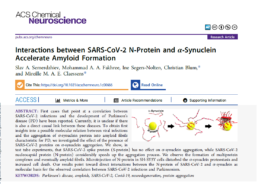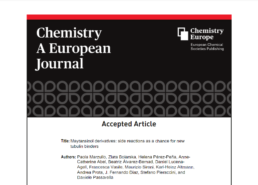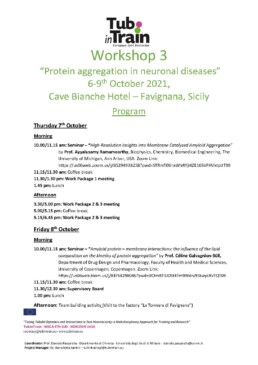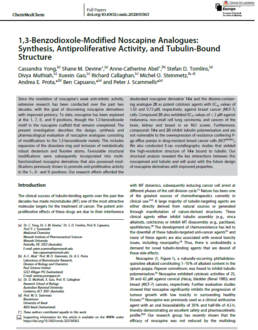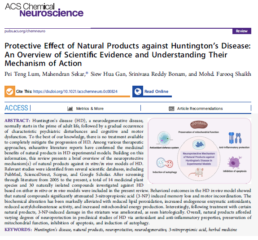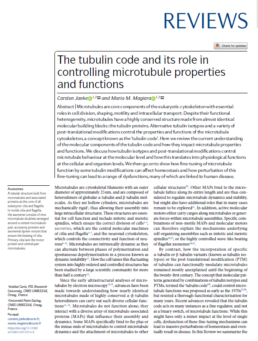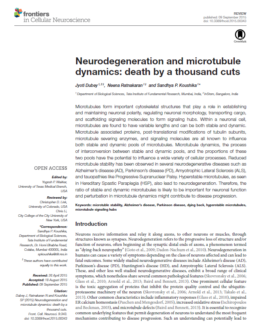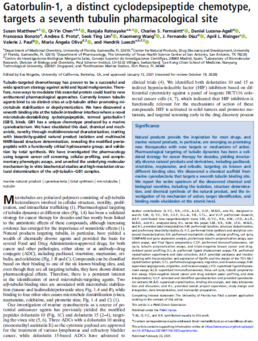Interactions between SARS-CoV‑2 N‑Protein and α‑Synuclein Accelerate Amyloid Formation
First cases that point at a correlation between SARS-CoV-2 infections and the development of Parkinson’s disease (PD) have been reported. Currently, it is unclear if there is also a direct causal link between these diseases. To obtain first insights into a possible molecular relation between viral infections and the aggregation of α-synuclein protein into amyloid fibrils characteristic for PD, we investigated the effect of the presence of
SARS-CoV-2 proteins on α-synuclein aggregation. We show, in test tube experiments, that SARS-CoV-2 spike protein (S-protein) has no effect on α-synuclein aggregation, while SARS-CoV-2 nucleocapsid protein (N-protein) considerably speeds up the aggregation process. We observe the formation of multiprotein
complexes and eventually amyloid fibrils. Microinjection of N-protein in SH-SY5Y cells disturbed the α-synuclein proteostasis and increased cell death. Our results point toward direct interactions between the N-protein of SARS-CoV-2 and α-synuclein as molecular basis for the observed correlation between SARS-CoV-2 infections and Parkinsonism.
https://www.tubintrain.eu/wp-content/uploads/2021/12/acschemneuro.1c00666.pdf
Maytansinol derivatives: side reactions as a chance for new tubulin binders
Maytansinol is a valuable precursor for the preparation of maytansine derivatives (known as maytansinoids). Inspired by its intriguing structure and their success in targeted cancer therapy, we explored the maytansinol acylation reaction. As a result, we were able to obtain a series of derivatives, bearing novel modifications of the maytansine scaffold. We characterized these molecules by docking studies, by a comprehensive biochemical evaluation and by
determination of their crystal structures in complex with tubulin. The obtained results shed further light on the intriguing chemical behavior of maytansinoids and confirm the relevance of this peculiar scaffold in the scenario of tubulin binders.
https://www.tubintrain.eu/wp-content/uploads/2021/11/Passarella-Pieraccini-Diaz-Prota.pdf
1,3-Benzodioxole-Modified Noscapine Analogues: Synthesis, Antiproliferative Activity, and Tubulin-Bound Structure
Since the revelation of noscapine’s weak anti-mitotic activity, extensive research has been conducted over the past two decades, with the goal of discovering noscapine derivatives with improved potency. To date, noscapine has been explored at the 1, 7, 6’, and 9’-positions, though the 1,3-benzodioxole motif in the noscapine scaffold that remains unexplored. The present investigation describes the design, synthesis and pharmacological evaluation of noscapine analogues consisting of modifications to the 1,3-benzodioxole moiety. This includes expansion of the dioxolane ring and inclusion of metabolically
robust deuterium and fluorine atoms. Favourable structural modifications were subsequently incorporated into multifunctionalised noscapine derivatives that also possessed modifications previously shown to promote anti-proliferative activity in the 1-, 6’- and 9’-positions. Our research efforts afforded the deuterated noscapine derivative 14e and the dioxino-containing analogue 20 as potent cytotoxic agents with EC50 values of 1.50 and 0.73 μM, respectively, against breast cancer (MCF-7) cells. Compound 20 also exhibited EC50 values of <2 μM against melanoma, non-small cell lung carcinoma, and cancers of the
brain, kidney and breast in an NCI screen. Furthermore, compounds 14e and 20 inhibit tubulin polymerisation and are not vulnerable to the overexpression of resistance conferring Pgp efflux pumps in drug-resistant breast cancer cells (NCIADR/RES). We also conducted X-ray crystallography studies that yielded
the high-resolution structure of 14e bound to tubulin. Our structural analysis revealed the key interactions between this noscapinoid and tubulin and will assist with the future design of noscapine derivatives with improved properties.
https://www.tubintrain.eu/wp-content/uploads/2021/08/Anne-Catherine-cmdc.202100363-3.pdf
Protective Effect of Natural Products against Huntington’s Disease: An Overview of Scientific Evidence and Understanding Their Mechanism of Action
Huntington’s disease (HD), a neurodegenerative disease, normally starts in the prime of adult life, followed by a gradual occurrence of characteristic psychiatric disturbances and cognitive and motor dysfunction. To the best of our knowledge, there is no treatment available to completely mitigate the progression of HD. Among various therapeutic approaches, exhaustive literature reports have confirmed the medicinal benefits of natural products in HD experimental models. Building on this information, this review presents a brief overview of the neuroprotective mechanism(s) of natural products against in vitro/in vivo models of HD. Relevant studies were identified from several scientific databases, including PubMed, ScienceDirect, Scopus, and Google Scholar. After screening through literature from 2005 to the present, a total of 14 medicinal plant species and 30 naturally isolated compounds investigated against HD based on either in vitro or in vivo models were included in the present review. Behavioral outcomes in the HD in vivo model showed that natural compounds significantly attenuated 3-nitropropionic acid (3-NP) induced memory loss and motor incoordination. The biochemical alteration has been markedly alleviated with reduced lipid peroxidation, increased endogenous enzymatic antioxidants, reduced acetylcholinesterase activity, and increased mitochondrial energy production. Interestingly, following treatment with certain natural products, 3-NP-induced damage in the striatum was ameliorated, as seen histologically. Overall, natural products afforded varying degrees of neuroprotection in preclinical studies of HD via antioxidant and anti-inflammatory properties, preservation of mitochondrial function, inhibition of apoptosis, and induction of autophagy.
The tubulin code and its role in controlling microtubule properties and functions
Microtubules are core components of the eukaryotic cytoskeleton with essential roles in cell division, shaping, motility and intracellular transport. Despite their functional heterogeneity , microtubules have a highly conserved structure made from almost identical molecular building blocks: the tubulin proteins. Alternative tubulin isotypes and a variety of post- translational modifications control the properties and functions of the microtubule cytoskeleton, a concept known as the ‘tubulin code’. Here we review the current understanding of the molecular components of the tubulin code and how they impact microtubule properties and functions. We discuss how tubulin isotypes and post- translational modifications control microtubule behaviour at the molecular level and how this translates into physiological functions at the cellular and organism levels. We then go on to show how fine- tuning of microtubule function by some tubulin modifications can affect homeostasis and how perturbation of this fine- tuning can lead to a range of dysfunctions, many of which are linked to human disease.
Neurodegeneration and microtubule dynamics: death by a thousand cuts
Microtubules form important cytoskeletal structures that play a role in establishing and maintaining neuronal polarity, regulating neuronal morphology, transporting cargo, and scaffold ingsignaling molecules to form signal inghubs. With in a neuronal cell, microtubules are foundt o have variable lengths and can be both stable and dynamic. Microtubule associated proteins, post-translational modifications of tubulin subunits, microtubules evering enzymes, and signaling molecules are all known to influence both stable and dynamic pools of microtubules. Microtubule dynamics, the process of interconversion between stable and dynamic pools, and the proportions of these two pools have the potential to influence a wide variety of cellular processes. Reduced microtubule stability has been observed in several neurodegenerative diseases such as Alzheimer’s disease(AD), Parkinson’s disease(PD), Amyotrophic Lateral Sclerosis(ALS), and tau opathies like Progressive Supranuclear Palsy. Hyperstable microtubules, as seen in Hereditary Spastic Paraplegia(HSP), also lead to neurodegeneration. Therefore, the ratio of stable and dynamic microtubules is likely to be important for neuronal function and perturbation in microtubule dynamics might contribute to disease progression.
https://www.tubintrain.eu/wp-content/uploads/2021/03/Anne-Catherine.fncel-09-00343-1.pdf
Gatorbulin-1, a distinct cyclodepsipeptide chemotype, targets a seventh tubulin pharmacological site
Tubulin-targeted chemotherapy has proven to be a successful and wide spectrum strategy against solid and liquid malignancies. Therefore, new ways to modulate this essential protein could lead to new antitumoral pharmacological approaches. Currently known tubulin agents bind to six distinct sites at α/β-tubulin either promoting microtubule stabilization or depolymerization. We have discovered a seventh binding site at the tubulin intradimer interface where a novel microtubule-destabilizing cyclodepsipeptide, termed gatorbulin-1 (GB1), binds. GB1 has a unique chemotype produced by a marine cyanobacterium. We have elucidated this dual, chemical and mechanistic, novelty through multidimensional characterization, starting with bioactivity-guided natural product isolation and multinuclei NMR-based structure determination, revealing the modified pentapeptide with a functionally critical hydroxamate group; and validation by total synthesis. We have investigated the pharmacology using isogenic cancer cell screening, cellular profiling, and complementary phenotypic assays, and unveiled the underlying molecular mechanism by in vitro biochemical studies and high-resolution structural determination of the α/β tubulin−GB1 complex.
https://www.tubintrain.eu/wp-content/uploads/2021/03/2021_Matthew.pdf

